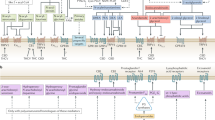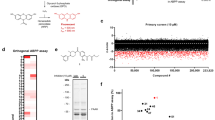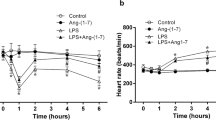Abstract
Anandamide, an endogenous cannabinoid ligand1, binds to CB1 cannabinoid receptors2 in the brain and mimics the neurobehavioural actions of marijuana3,4. Cannabinoids and anandamide also elicit hypotension mediated by peripheral CB1 receptors5,6,7,8. Here we report that a selective CB1 receptor antagonist, SR141716A9, elicits an increase in blood pressure in rats subjected to haemorrhagic shock, whereas similar treatment of normotensive rats or intracerebroventricular administration of the antagonist during shock do not affect blood pressure. Blood from haemorrhaged rats causes hypotension in normal rats, which can be prevented by SR141716A but not by inhibition of nitric oxide synthase in the recipient. Macrophages and platelets from haemorrhaged rats elicit CB1 receptor-mediated hypotension in normotensive recipients, and incorporate arachidonic acid or ethanolamine into a product that co-elutes with anandamide on reverse-phase high-performance liquid chromatography. Also, macrophages from control rats stimulated with ionomycin or bacterial phospholipase D produce anandamide, as identified by gas chromatography and mass spectrometry. These findings indicate that activation of peripheral CB1 cannabinoid receptors contributes to haemorrhagic hypotension, and anandamide produced by macrophages may be a mediator of this effect.
This is a preview of subscription content, access via your institution
Access options
Subscribe to this journal
Receive 51 print issues and online access
$199.00 per year
only $3.90 per issue
Buy this article
- Purchase on Springer Link
- Instant access to full article PDF
Prices may be subject to local taxes which are calculated during checkout






Similar content being viewed by others
References
Devane, W. A. et al. Isolation and structure of a brain constituent that binds to the cannabinoid receptor. Science 258, 1946–1948 (1992).
Matsuda, L. A., Lolait, S. J., Brownstein, M. J., Young, A. C. & Bonner, T. I. Structure of a cannabinoid receptor and functional expression of the cloned cDNA. Nature 346, 561–564 (1990).
Fride, E. & Mechoulam, R. Pharmacological activity of the cannabinoid receptor agonist, anandamide, a brain constituent. Eur. J. Pharmacol. 231, 313–314 (1993).
Smith, P. B. et al. The pharmacological activity of anandamide, a putative endogenous cannabinoid, in mice. J. Pharmacol. Exp. Ther. 270, 219–227 (1994).
Varga, K., Lake, K. D., Martin, B. R. & Kunos, G. Novel antagonist implicates the CB1 cannabinoid receptor in the hypotensive action of anandamide. Eur. J. Pharmacol. 278, 279–283 (1995).
Varga, K., Lake, K. D., Huangfu, D., Guyenet, P. G. & Kunos, G. Mechanism of the hypotensive action of anandamide in anesthetized rats. Hypertension 28, 682–688 (1996).
Lake, K. D., Martin, B. R., Kunos, G. & Varga, K. Cardiovascular effects of anandamide in anesthetized and conscious normotensive and hypertensive rats. Hypertension 29, 1204–1210 (1997).
Lake, K. D., Varga, K., Compton, D. R. & Kunos, G. Cannabinoid-induced hypotension and bradycardia in rats is mediated by CB1 cannabinoid receptors. J. Pharmacol. Exp. Ther. 281, 1030–1037 (1997).
Rinaldi-Carmona, M. et al. SR141716A, a potent and selective antagonist of the brain cannabinoid receptor. FEBS Lett. 350, 240–244 (1994).
Peitzmann, A. B. et al. Hemorrhagic shock. Curr. Probl. Surg. 32, 927–1002 (1995).
Holaday, J. W. Cardiovascular effects of endogenous opiate systems. A. Rev. Pharmacol. Toxicol. 23, 541–594 (1983).
Felder, C. C., Veluz, J. S., Williams, H. L., Briley, E. M. & Matsuda, L. A. Cannabinoid agonists stimulate both receptor- and non-receptor-mediated signal transduction pathways in cells transfected with an expressing cannabinoid receptor clones. Mol. Pharmacol. 42, 838–845 (1992).
Myers, P. R., Minor, R. L., Guerra, R., Bates, J. N. & Harrison, D. G. Vasorelaxant properties of the endothelium-derived relaxing factor more closely resemble N-nitrosocystein than nitric oxide. Nature 345, 161–163 (1990).
Knowles, R. G. & Moncada, S. Nitric oxide synthases in mammals. Biochem. J. 298, 249–258 (1994).
Naziri, W. et al. Hemorrhagic shock-induced alterations in circulating and bronchoalveolar macrophage nitric oxide production. J. Surg. Res. 59, 146–152 (1995).
Ellis, E. F., Moore, S. S. & Willoughby, K. A. Anandamide and Δ9-THC dilation of cerebral arterioles is blocked by indomethacin. Am. J. Physiol. 269, H1859–H1864 (1995).
Gebremedhin, G., Campbell, W. B., Hillard, C. J. & Harder, D. R. Inhibitory effects of anandamide on Ca2+ currents in cat cerebral arterial smooth muscle cells. FASEB J. 10, A302 (1996).
Di Marzo, V. et al. Formation and inactivation of endogenous cannabinoid anandamide in central neurons. Nature 372, 686–691 (1994).
Di Marzo, V., De Petrocellis, L., Sepe, N. & Buono, A. Biosynthesis of anandamide and related acylethanolamides in mouse J774 macrophages and N18 neuroblastoma cells. Biochem. J. 316, 977–984 (1996).
Bisogno, T., Maurelli, S., Melck, D., De Petrocellis, L. & Di Marzo, V. Biosynthesis, uptake, and degradation of anandamide and palmitoylethanolamide in leukocytes. J. Biol. Chem. 272, 3315–3323 (1997).
Amrutesh, S. C., Falck, J. R. & Ellis, E. F. Brain synthesis and cerebrovascular action of epoxygenase metabolites of arachidonic acid. J. Neurochem. 58, 503–510 (1992).
Aiura, K. et al. Interaction with autologous platelets multiplies interleukin-1 and tumor necrosis factor production in mononuclear cells. J. Inf. Dis. 175, 123–129 (1997).
Collins, J. A., Braitberg, A., Margraf, H. W. & Butcher, H. R. Hemorrhagic shock in rats. Arch. Surg. 99, 484–488 (1969).
Böyum, A. Isolation of mononuclear cells and granulocytes from human blood. Scand. J. Lab. Clin. Invest. 21 (suppl. 97), 77–89 (1968).
Cortas, N. K. & Wakid, N. W. Determination of inorganic nitrate in serum and urine by a kinetic cadmium-reduction method. Clin. Chem. 36, 1440–1443 (1990).
Acknowledgements
We thank K. Willoughby for help with the HPLC assays, T. Bridgen for help with GC/MS, E. Ishac for preparing illustrations and J. Lowe for providing SR141716A. This work was funded by grants from the American Heart Association Virginia Affiliate and from the National Institutes of Health. J.A.W. was supported by a fellowship from the Deutsche Forschungsgemeinschaft.
Author information
Authors and Affiliations
Corresponding author
Rights and permissions
About this article
Cite this article
Wagner, J., Varga, K., Ellis, E. et al. Activation of peripheral CB1 cannabinoid receptors in haemorrhagic shock. Nature 390, 518–521 (1997). https://doi.org/10.1038/37371
Received:
Accepted:
Issue Date:
DOI: https://doi.org/10.1038/37371
This article is cited by
-
Integrating Endocannabinoid Signalling In Depression
Journal of Molecular Neuroscience (2021)
-
Cardiovascular effects of marijuana and synthetic cannabinoids: the good, the bad, and the ugly
Nature Reviews Cardiology (2018)
-
Cardiovascular Complications of Marijuana and Related Substances: A Review
Cardiology and Therapy (2018)
-
Phospholipids in mitochondrial dysfunction during hemorrhagic shock
Journal of Bioenergetics and Biomembranes (2017)
-
Acute Stress Increases Circulating Anandamide and Other N-Acylethanolamines in Healthy Humans
Neuropsychopharmacology (2012)
Comments
By submitting a comment you agree to abide by our Terms and Community Guidelines. If you find something abusive or that does not comply with our terms or guidelines please flag it as inappropriate.



